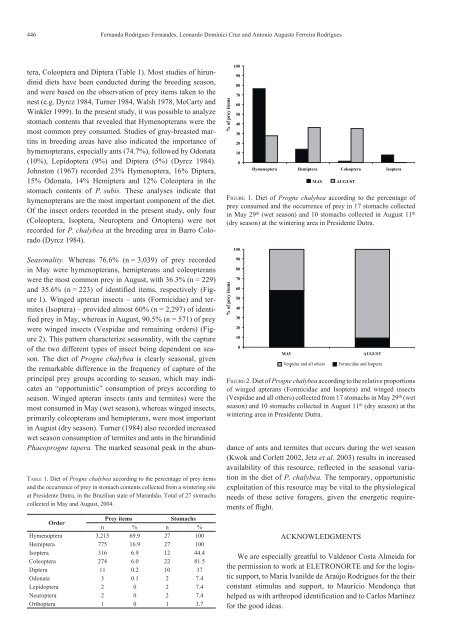You also want an ePaper? Increase the reach of your titles
YUMPU automatically turns print PDFs into web optimized ePapers that Google loves.
446 Fernan<strong>da</strong> Rodrigues Fernandes, Leonardo Dominici Cruz and Antonio Augusto Ferreira Rodrigues<br />
tera, Coleoptera and Diptera (Table 1). Most studies of hirundinid<br />
diets have been conducted during the breeding season,<br />
and were based on the observation of prey items taken to the<br />
nest (e.g. Dyrcz 1984, Turner 1984, Walsh 1978, McCarty and<br />
Winkler 1999). In the present study, it was possible to analyze<br />
stomach contents that revealed that Hymenopterans were the<br />
most common prey consumed. Studies of gray-breasted martins<br />
in breeding areas have also indicated the importance of<br />
hymenopterans, especially ants (74.7%), followed by Odonata<br />
(10%), Lepidoptera (9%) and Diptera (5%) (Dyrcz 1984).<br />
Johnston (1967) recorded 23% Hymenoptera, 16% Diptera,<br />
15% Odonata, 14% Hemiptera and 12% Coleoptera in the<br />
stomach contents of P. subis. These analyses indicate that<br />
hymenopterans are the most important component of the diet.<br />
Of the insect orders recorded in the present study, only four<br />
(Coleoptera, Isoptera, Neuroptera and Ortoptera) were not<br />
recorded for P. chalybea at the breeding area in Barro Colorado<br />
(Dyrcz 1984).<br />
Seasonality. Whereas 76.6% (n = 3,039) of prey recorded<br />
in May were hymenopterans, hemipterans and coleopterans<br />
were the most common prey in August, with 36.3% (n = 229)<br />
and 35.6% (n = 223) of identified items, respectively (Figure<br />
1). Winged apteran insects – ants (Formici<strong>da</strong>e) and termites<br />
(Isoptera) – provided almost 60% (n = 2,297) of identified<br />
prey in May, whereas in August, 90.5% (n = 571) of prey<br />
were winged insects (Vespi<strong>da</strong>e and remaining orders) (Figure<br />
2). This pattern characterize seasonality, with the capture<br />
of the two different types of insect being dependent on season.<br />
The diet of Progne chalybea is clearly seasonal, given<br />
the remarkable difference in the frequency of capture of the<br />
principal prey groups according to season, which may indicates<br />
an “opportunistic” consumption of preys according to<br />
season. Winged apteran insects (ants and termites) were the<br />
most consumed in May (wet season), whereas winged insects,<br />
primarily coleopterans and hemipterans, were most important<br />
in August (dry season). Turner (1984) also recorded increased<br />
wet season consumption of termites and ants in the hirundinid<br />
FiguRe 1. Diet of Progne chalybea according to the percentage of<br />
prey consumed and the occurrence of prey in 17 stomachs collected<br />
in May 29 th (wet season) and 10 stomachs collected in August 11 th<br />
(dry season) at the wintering area in Presidente Dutra.<br />
FiguRe 2. Diet of Progne chalybea according to the relative proportions<br />
of winged apterans (Formici<strong>da</strong>e and Isoptera) and winged insects<br />
(Vespi<strong>da</strong>e and all others) collected from 17 stomachs in May 29 th (wet<br />
season) and 10 stomachs collected in August 11 th (dry season) at the<br />
wintering area in Presidente Dutra.<br />
Phaeoprogne tapera. The marked seasonal peak in the abun- <strong>da</strong>nce of ants and termites that occurs during the wet season<br />
(Kwok and Corlett 2002, Jetz et al. 2003) results in increased<br />
availability of this resource, reflected in the seasonal varia-<br />
Table 1. Diet of Progne chalybea according to the percentage of prey items<br />
and the occurrence of prey in stomach contents collected from a wintering site<br />
at Presidente Dutra, in the Brazilian state of Maranhão. Total of 27 stomachs<br />
collected in May and August, 2004.<br />
Order<br />
Prey items<br />
n %<br />
Stomachs<br />
n %<br />
Hymenoptera 3,215 69.9 27 100<br />
Hemiptera 775 16.9 27 100<br />
Isoptera 316 6.9 12 44.4<br />
Coleoptera 274 6.0 22 81.5<br />
Diptera 11 0.2 10 37<br />
Odonata 3 0.1 2 7.4<br />
Lepidoptera 2 0 2 7.4<br />
Neuroptera 2 0 2 7.4<br />
Orthoptera 1 0 1 3.7<br />
tion in the diet of P. chalybea. The temporary, opportunistic<br />
exploitation of this resource may be vital to the physiological<br />
needs of these active foragers, given the energetic requirements<br />
of flight.<br />
ACKNOWLEDGMENTS<br />
We are especially greatful to Valdenor Costa Almei<strong>da</strong> for<br />
the permission to work at ELETRONORTE and for the logistic<br />
support, to Maria Ivanilde de Araújo Rodrigues for the their<br />
constant stimulus and support, to Maurício Mendonça that<br />
helped us with arthropod identification and to Carlos Martínez<br />
for the good ideas.

















